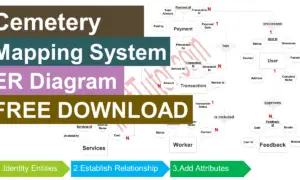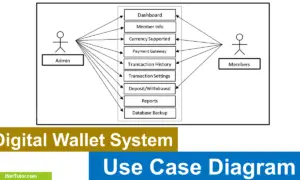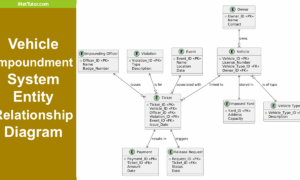Online Grading with Grade Viewing Conceptual Framework
This post will guide you on how to create a conceptual framework for the project Online with Grade Viewing System using input, process, and output (IPO) model.
About the Project
Table of Contents
The capstone project, “Free Online Grading System with Grade Viewing” is an online platform for processing and viewing of grades. The said project will assist the faculties to process and release grades of students and also let students to view their grades electronically.
Faculties in schools currently uses the manual approach in processing the grades of their students which involves loads of paper works and takes a lot of time. The current method will make it difficult for the faculties to process the grades of the students since they will manually enter the grades. The processes involve are prone to errors that may affect the accuracy and fairness of the grades. Students also will personally visit the registrar’s office to request for their grades which will cost them time and effort and also fare expense. The existing method is inefficient and can be further improve by using technology.
Objectives of the Study
- To design a system that will let faculties process and release student grades efficiently.
- The system will allow students to view their grades in a more convenient and time-saving way.
- The system will aid the registrar’s office in attending to student’s grade inquiry.
- To develop a system that will make grade processing, releasing and viewing convenient for students and faculties.
- The system will make grade-related transactions easy, fast and hassle-free.
What is a Conceptual Framework?
A conceptual framework is a set of assumptions, concepts, values, and practices that underlie the research being conducted. It serves as a basis for the research, guiding the collection and analysis of data and informing the interpretation of results. The conceptual framework helps to define the key concepts and variables being studied and establishes the relationships among them. It also provides a framework for organizing the research and communicating the results to others.
In research, the conceptual framework is an important tool for ensuring that the study is well-designed and that the results are properly interpreted. It helps researchers to be explicit about the assumptions and expectations that are driving the research and to consider alternative explanations for the findings. A well-defined conceptual framework can also help to identify any gaps in the current understanding of a topic and to suggest directions for future research.
Conceptual Framework Diagram
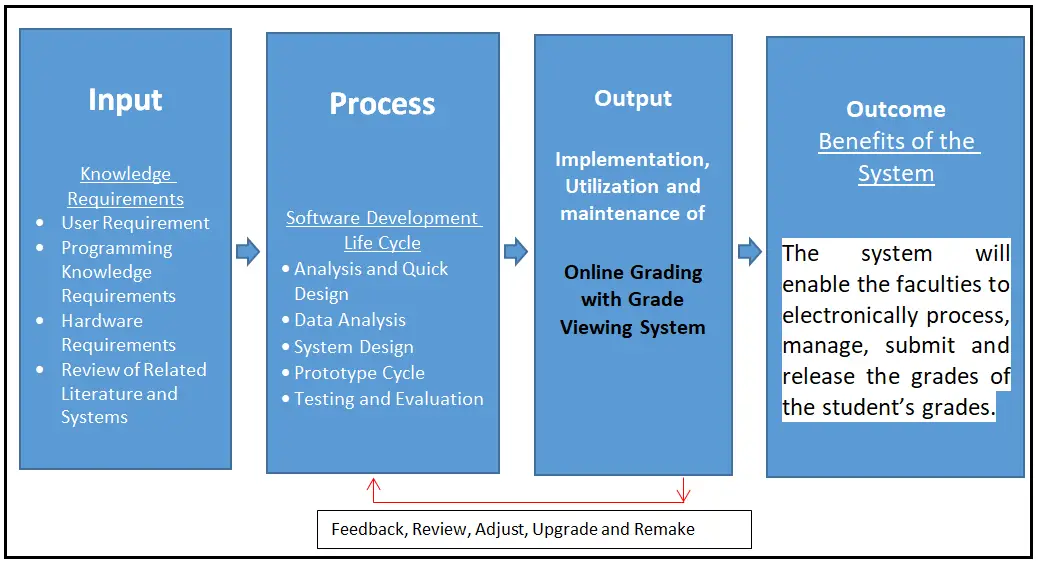
The image above is the conceptual framework of the project entitled Online Online Grading with Grade Viewing System. It is based on IPO model or also known as the input, process and output model.
Input
The input phase or the knowledge requirement stage consists of the following:
User Requirement – The researchers conducted an interview with different educational institutions to learn about their demands so that the team could design a solution that would handle their current issues.
Programming Knowledge – After establishing the difficulties, a solution must be supplied, which is in the form of an information system developed in a programming language in which the researchers have appropriate understanding. For the project, the researchers will employ PHP, MySQL, and Bootstrap.
Hardware Requirements – The system cannot function without the assistance of hardware such as a computer and mobile devices. The researchers indicated to the user that they required such hardware in order to effectively exploit the information system.
Related Literature and Systems – To serve as a guide in the construction of the Online Grading with Grade Viewing, the researchers performed study on various literatures and related systems.
Process
Analysis and Quick Design
During Analysis and Quick Design, the researchers conducted a personal interview with the respondents and the chosen client. Respondents were asked to submit suggestions for how the system should be designed. Following data collecting, the researchers developed a preliminary design for the proposed system.
Data Analysis
All data, user requirements, and information will be analyzed by the researchers. This phase also allows the researchers to get a sense of how to build the system and how the suggested system would benefit the clients.
System Design
The researchers will begin work on the proposed system. It contains the design; how the system would look based on user requirements, and whether or not the researchers/programmers would like to add personal design to make the system more interactive and user pleasant.
Prototype Cycle
During this step, the researchers’ data will be compiled, built, demonstrated, and polished. The researchers begin by developing a prototype based on the desired design and data tables. After it has been built, the prototype will be shown to the client. The researchers show how the system works, the flow of how it works, and the functions of the system’s features. The researchers will next fine-tune the system based on the client’s additional requirements throughout the refining stage. Changes to the feature flow and functionalities will be made in response to user feedback.
Testing and Evaluation
This will contain the feed-back of the planned system after it has been implemented and tested by three experts. It will also notify the researchers and developers if there are any errors, suggestions, or if the system’s functionality will function properly.
This will be a discussion about the implementation of the proposed system, with three (3) experts evaluating it. This will also include whether or not the recommended functions and suggestions are met.
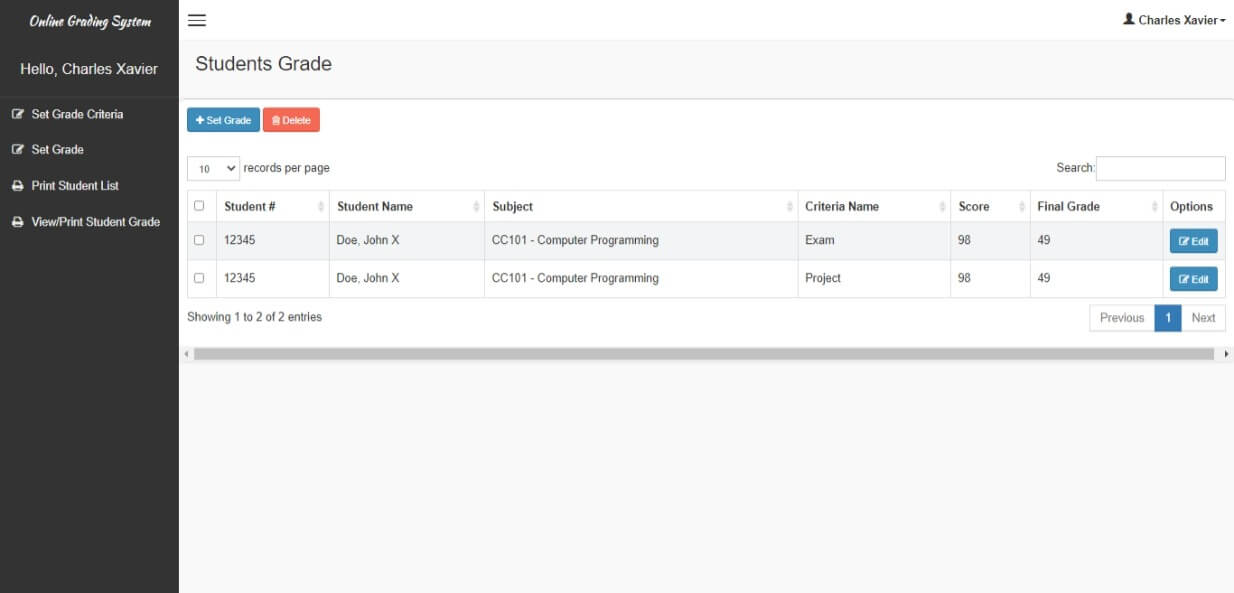
Output
The ultimate goal of the research is to create a database-driven information system that will replace or aid respondents in managing grades of students. The implementation of the system is actively encouraged.
Outcome
Benefits of the System:
- The system will enable the faculties to electronically process, manage, submit and release the grades of the student’s grades.
- Improved accuracy: An online grading system can help to reduce the risk of errors in grading, as it allows for the use of automated grading tools and eliminates the need for manual calculations.
- Increased efficiency: An online grading system can save time and effort for both students and instructors, as it allows for quick and easy access to grades and feedback.
- Enhanced communication: With a grade viewing system, students can view their grades and feedback in real-time, which can facilitate communication between instructors and students.
- Greater transparency: An online grading system can increase transparency in the grading process, as students can see exactly how their grades were calculated and can request clarification if they do not understand their feedback.
- Improved accountability: An online grading system can promote accountability, as students are able to see their grades immediately after an assignment is submitted and can track their progress over time.
- Enhanced student engagement: By providing students with timely and detailed feedback, an online grading system can help to improve student engagement and motivation.
Summary
The purpose of this research is to build the conceptual framework for the investigation. In this study, the researchers employed the IPO model as a foundation for building the conceptual framework. The input phase, which includes User Requirements, Programming Knowledge Requirements, Hardware Requirements, and a Review of Related Literature and Systems, is the first stage. The researchers will develop the system utilizing the Software Development Life Cycle (SDLC) technique during the process phase. The SDLC technique includes components such as analysis and quick design, data analysis, system design, prototype cycle, and testing and assessment. The ultimate goal of the research is to create a database-driven information system that will replace or aid respondents in managing grades of students. The system will enable the faculties to electronically process, manage, submit and release the grades of the students’ grades. The implementation of the system is actively encouraged.
Readers are also interested in:
Grading and Grade Viewing System Use Case Diagram
Free Online Grading System with Grade Viewing
Online Grading System with Grade Viewing Capstone Project
You may visit our Facebook page for more information, inquiries, and comments. Please subscribe also to our YouTube Channel to receive free capstone projects resources and computer programming tutorials.
Hire our team to do the project.
